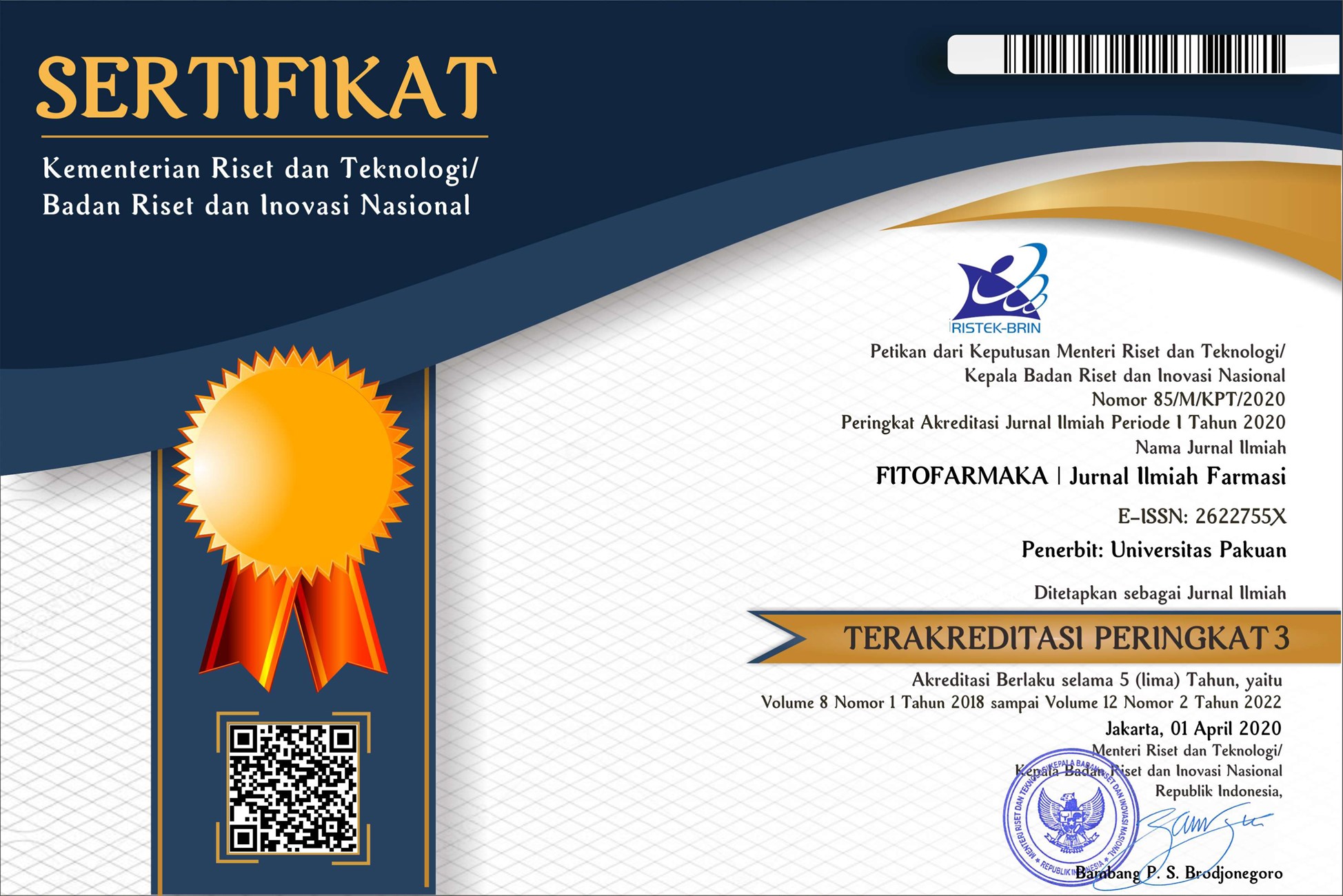SKRINING TOKSISITAS AKUT BEBERAPA FRAKSI BUAH KARONDA (Carissa carandas L.) PADA EMBRIO ZEBRAFISH (Danio rerio)
Abstract
Dalam pengembangan obat baru, perlu dilakukan penelitian untuk menentukan keamanan dan efek dari suatu tanaman obat. Buah karonda (Carissa carandas L.) adalah tanaman yang memiliki potensi sebagai obat anti-inflamasi. Penelitian ini bertujuan untuk menentukan toksisitas akut fraksi n-heksana, etil asetat, dan air buah karonda menggunakan model hewan uji embrio ikan zebra (Danio rerio). Pengujian toksisitas akut mengacu pada protokol OECD No. 236 tahun 2012 dan dilakukan pengamatan perubahan morfologi embrio ikan zebra yaitu tulang ekor, yolk sac dan pericardium. Hasil toksisitas fraksi n-heksana, etil asetat, dan air masing-masing menunjukkan nilai LC50 adalah 608,26 μg/mL; 571,78 μg/mL; dan 546,69 μg/mL. Hasil pengamatan perubahan morfologi pada usia 96 hours post fertilization (hpf) pada ketiga fraksi menunjukkan kelainan perubahan pada tulang ekor, edema yolk sac dan pericardium. Kategori ketoksikan bahan uji termasuk kategori tidak toksik.
Keywords
References
Anupama, N., Madhumitha, G. & Rajesh, K. S. 2014. Role of dried fruits of Carissa carandas as anti-inflammatory agents and the analysis of phytochemical constituents by GC-MS. BioMed Research International, Special Issue.
Azeez, S., Karunakaran, G., Tripathi, P. C., Shivashankara, K. S., & Roy, T. K. 2016. Evaluation of antioxidant activity, total phenolics and phytochemical content of selected varieties of karonda fruits (Carissa carandas). Indian Journal of Agricultural Sciences, 86(6): 815-822.
Depkes RI. 1992. Pedoman Fitofarmaka Dalam Keputusan Menteri Kesehatan Republik Indonesia Nomor 761/Menkes/SK/IX/1992. Departemen Kesehatan Republik Indonesia. Jakarta.
Dhodi, J. B., Thanekar, D. R., Mestry, S. N. & Juvekar, A. R. 2015. Carissa carandas Linn. fruit extract ameliorates gentamicininduced nephrotoxicity in rats via attenuation of oxidative stress. Journal of Acute Disease, 4(2): 135-140.
El-Sayed Ali, T. & Legler, J. 2011. Developmental toxicity of nonylphenol in zebrafish (Danio rerio) embryos. Indian Journal of Marine Sciences, 40(4): 509-515.
Gad, S. C. 2014. LD50/LC50 (Lethal Dosage 50/Lethal Concentration 50) in Encyclopedia of Toxicology Third Ed, Editor: Wexler, P. Academic Press. USA.
Gusrina, G. 2014. Genetika dan Reproduksi Ikan. Deepublish.
Hanani, E. 2015. Analisis Fitokimia. Penerbit Buku Kedokteran EGC. Jakarta.
Harborne, J. B., Padmawinata, K. & Soediro, I. 2006. Metode Fitokimia Penuntun Cara Modern Menganalisis Tumbuhan. ITB
Huang, D., Li, H., He, Q., Yuan, W., Chen, Z. & Yang, H. 2018. Developmental toxicity of diethylnitrosamine in zebrafish Embryos/juveniles related to excessive oxidative stress. Water, Air, and Soil Pollution, 229(3): 81.
Kemenkes RI. 2011. Suplemen II Farmakope Herbal Indonesia. Departemen Kesehatan Republik Indonesia.
Mishra, C., Sasmal, D. & Kumar, D. 2017. In vitro antioxidant activity of chloroform and ethanolic fruit and root extracts of Carissa carandas Linn. J.Bio.Innov, 6(5): 741748.
OECD (Organisation for Economic Co-operation and Development). 2012. OECD guideline for testing of chemicals: fish, acute toxicity test.
Parasuraman, S. 2011. Toxicological screening. Journal of Pharmacology & Pharmacotherapeutics, 2(2): 74-79.
Rohmah, J., Rini, C. S. & Wulandari, F. E. 2019. Aktivitas sitotoksik ekstrak selada merah (Lactuca Sativa var. crispa) pada berbagai pelarut ekstraksi. Jurnal Kimia Riset, 4(1): 18-32.
Rubinstein, A. L. 2006. Zebrafish assays for drug toxicity screening. Expert Opinion on Drug Metabolism and Toxicology, 2(2): 231-240.
Sudjaroen, Y. & Suwannahong, K. 2017. In vitro antioxidant, antibacterial, and cytotoxicity activities from Karanda (Carissa carandas L.) fruit extracts. International Journal of Green Pharmacy, 11(1): 189-193.
Van den Bulck, K., Hill, A., Mesens, N., Diekman, H., De Schaepdrijver, L. & Lammens, L. 2011. Zebrafish developmental toxicity assay: A fishy solution to reproductive toxicity screening, or just a red herring?. Reproductive Toxicology, 32(2): 213-219.
Virmani, R., Virmani, T., Sorout, G. & Gupta, J. 2017. Buccal drug delivery system- approach to improve the bioavailability. Research in Pharmacy and Health Sciences, 3(2): 294-302.
Waynon, W. J. & Finley, M. F. 1980. Handbook of Acute Toxicity of Chemicals to Fish and Aquatic Invertebrates. United States Department of the Interior Fish and Wildlife Service, Resources Publication. USA.
Yang, J., Li, W., Liu, Y., Wang, Q., Cheng, X. & Wei, F. 2018. Acute toxicity screening of different extractions, components and constituents of Polygonum multiflorum Thunb. on zebra fish (Danio rerio) embryos in vivo. Biomedicine and Pharmacotherapy. 99(1): 205- 213.
DOI: 10.33751/jf.v10i1.1923
 Abstract views : 2307
Abstract views : 2307
Refbacks
- There are currently no refbacks.













